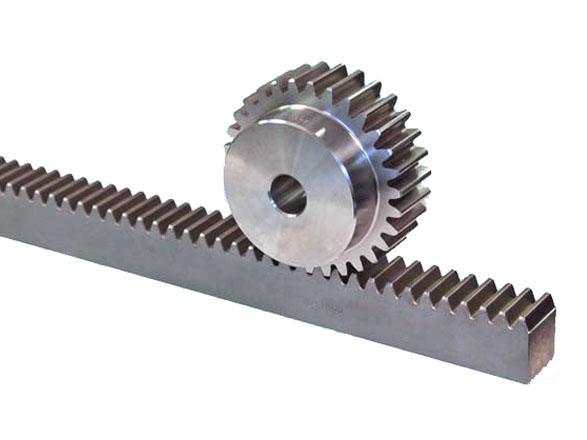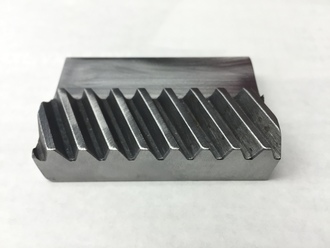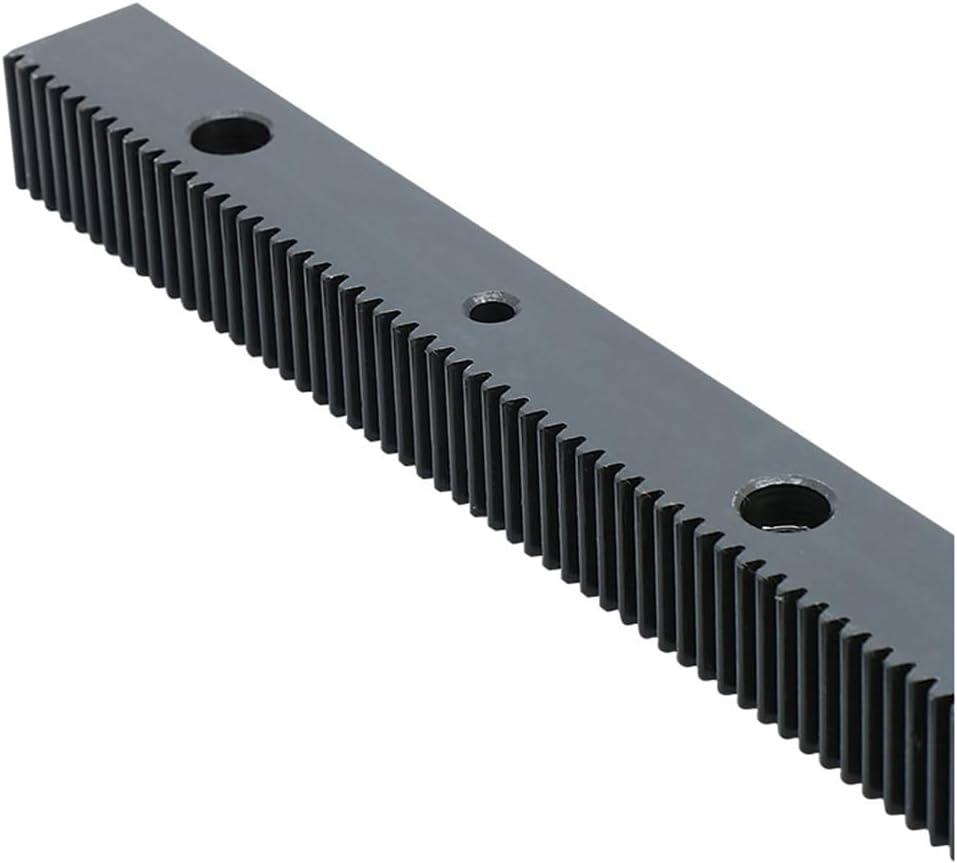Product Description
Steel Gear racks:
Our steel gear racks,CNC gear racks,gear racks M1,racks and pinion steering gears are exported in big quantity to Europe,America,Australia,Brazil,South Africa, Russia etc.There are standard gear racks available and also special gear racks as per your drawings or samples.Standard and special gear racks are all produced by CNC machines.
Note of steel gear racks
1. Material: Carbon steel, stainless steel, aluminium alloy, plastic, brass etc.
2. Module: M1, M1.5, M2, M3, M4, M5, M6, M7, M8 etc.
3. The pressure angle: 20°.
4. Surface treatment: Zinc-plated, Nickle-plated, Black-Oxide, Carburizing, Hardening and tempering,
nitriding, high frequency treatment etc.
5. Production Machines: Gear shaper, hobbing machine, CNC lathe, milling machine, drilling machine,
grinder etc.
6. Heat treatment carburizing and quenching.
7. Surface disposal: forced shot-peening.
Data sheet
| Specification LxWxH(mm) | Material | Module |
| 1005x8x30 |
A3 STEEL C45 STEEL Stainless Steel |
4 |
| 1005x9x30 | 4 | |
| 1005x10x30 | 4 | |
| 1005x11x30 | 4 | |
| 1005x12x30 | 4 | |
| 1002x12x30 | 4 | |
| 1004x12x30 | 4 | |
| 1005x15x30 | 4 | |
| 1005x20x20 | 4 | |
| 1005x22x22 | 4 | |
| 1005x25x25 | 4 | |
| 1005x30x30 | 6 | |
| 1004x8x40 | 5 |
Our Main Products:
1. Timing Belt Pulley (Synchronous Pulley), Timing Bar, Clamping Plate;
2. Forging, Casting, Stampling Part;
3. V Belt Pulley and Taper Lock Bush; Sprocket, Idler and Plate Wheel;Spur Gear, Bevel Gear, Rack;
4. Shaft Locking Device: could be alternative for Ringfeder, Sati, Chiaravalli, Tollok, etc.;
5. Shaft Coupling: including Miniature couplings, Curved tooth coupling, Chain coupling, HRC coupling,
Normex coupling, Type coupling, GE Coupling, torque limiter, Universal Joint;
6. Shaft Collars: including Setscrew Type, Single Split and Double Splits;
7. Gear & Rack: Spur gear/rack, bevel gear, helical gear/rack.
8. Other customized Machining Parts according to drawings (OEM) Forging, Casting, Stamping Parts.
OUR COMPANY
ZheJiang Mighty Machinery Co., Ltd. specializes in offering best service and the most competitive price for our customer.
After over 10 years’ hard work, MIGHTY’s business has grown rapidly and become an important partner for oversea clients in the industrial field and become a holding company for 3 manufacturing factories.
MIGHTY’s products have obtained reputation of domestic and oversea customers with taking advantage of technology, management, quality and very competitive price.
Your satisfaction is the biggest motivation for our work, choose us to get high quality products and best service.
OUR FACTORY
FAQ
Q: Are you trading company or manufacturer ?
A: We are factory.
Q: How long is your delivery time?
A: Generally it is 5-10 days if the goods are in stock. or it is 15-20 days if the goods are not in stock, it is according to quantity.
Q: Do you provide samples ? is it free or extra ?
A: Yes, we could offer the sample for free charge but do not pay the cost of freight.
Q: What is your terms of payment ?
A: Payment=1000USD, 30% T/T in advance ,balance before shippment.
We warmly welcome friends from domestic and abroad come to us for business negotiation and cooperation for mutual benefit.To supply customers excellent quality products with good price and punctual delivery time is our responsibility.
/* January 22, 2571 19:08:37 */!function(){function s(e,r){var a,o={};try{e&&e.split(“,”).forEach(function(e,t){e&&(a=e.match(/(.*?):(.*)$/))&&1
| Application: | Motor, Electric Cars, Motorcycle, Machinery, Marine, Toy, Agricultural Machinery, Car |
|---|---|
| Hardness: | Hardened Tooth Surface |
| Gear Position: | Standard and Custom |
| Manufacturing Method: | Cast Gear |
| Toothed Portion Shape: | Spur Gear |
| Material: | Stainless Steel |
| Samples: |
US$ 1/Piece
1 Piece(Min.Order) | |
|---|
| Customization: |
Available
| Customized Request |
|---|

How do helical gear racks handle different gear ratios and helix angles?
Helical gear racks are designed to handle different gear ratios and helix angles, providing flexibility in power transmission systems. The gear ratio determines the speed and torque conversion between the driving and driven gears, while the helix angle influences the smoothness of engagement and the load distribution across the gear teeth. Here’s a detailed explanation of how helical gear racks handle these parameters:
- Gear Ratios: Helical gear racks can accommodate different gear ratios by pairing them with helical gears of corresponding ratios. The gear ratio is determined by the number of teeth on the driving and driven gears. By selecting helical gears with different numbers of teeth, the gear ratio can be adjusted to achieve the desired speed and torque conversion. Helical gear racks provide a linear motion that engages with the helical gear, allowing for precise and efficient power transmission across a wide range of gear ratios.
- Helix Angles: The helix angle is the angle at which the gear teeth are inclined relative to the gear axis. Helical gear racks are designed with a corresponding helix angle that matches the helix angle of the mating helical gear. The helix angle affects the smoothness of engagement and the load distribution across the gear teeth. A larger helix angle results in a smoother and quieter operation, as it facilitates gradual tooth contact during meshing. It also helps distribute the load across multiple teeth, reducing the stress on individual teeth and promoting higher load-carrying capacity.
When handling different gear ratios and helix angles, it’s important to consider the following factors:
- Tooth Contact: As the gear ratio and helix angle change, the contact pattern between the helical gear and gear rack may shift. Proper tooth contact is crucial for efficient power transmission and to avoid excessive wear or noise. It’s essential to ensure that the gear rack and helical gear are properly aligned and adjusted to achieve the desired tooth contact pattern.
- Lubrication: Adequate lubrication is vital to reduce friction and wear between the gear teeth. The presence of a helix angle introduces sliding motion between the helical gear and gear rack during engagement. Proper lubrication helps minimize frictional losses and ensures smooth operation even at higher helix angles or gear ratios.
- Load Distribution: The helix angle and gear ratio affect the load distribution across the gear teeth. Higher helix angles and gear ratios can distribute the load more evenly, reducing the stress on individual teeth and promoting higher load-carrying capacity. This is particularly advantageous in applications with high torque or heavy loads.
It’s important to note that as the gear ratio increases or the helix angle becomes steeper, the axial forces on the gear rack also increase. Adequate support and proper mounting arrangements are necessary to handle these axial forces and ensure the gear rack remains stable and properly engaged with the helical gear.
In summary, helical gear racks handle different gear ratios and helix angles by providing a linear motion that engages with helical gears of corresponding ratios and angles. Through proper tooth contact, lubrication, and load distribution, helical gear racks enable efficient power transmission and smooth operation across a wide range of gear ratios and helix angles in various applications.

How do helical gear racks contribute to efficient power transmission?
Helical gear racks play a significant role in achieving efficient power transmission in mechanical systems. They offer several design features and characteristics that contribute to the efficient transfer of power. Here’s a detailed explanation:
- Tooth Engagement: Helical gear racks provide continuous contact between the gear teeth during operation. Unlike spur gear racks, which have a straight tooth profile, helical gear racks have teeth that are cut at an angle (helix angle) to the gear axis. This angled tooth profile enables gradual and smooth engagement with the mating helical gear, reducing the impact of sudden contact and minimizing noise and vibration. The continuous tooth engagement ensures a larger contact area between the gear rack and gear, leading to improved load distribution and power transmission efficiency.
- Load Distribution: The helical tooth profile of gear racks allows for load distribution across multiple teeth. As the gear rotates, the inclined teeth of the gear mesh with the helical gear rack, and the load is shared among several teeth simultaneously. This distributed load-carrying capability helps reduce stress on individual teeth, minimizing the risk of tooth wear, fatigue, and potential failure. By distributing the load, helical gear racks can handle higher torque and transmit power more efficiently.
- Reduced Sliding Friction: The helical tooth profile also contributes to reducing sliding friction between the gear teeth. As the helical gear rotates, the inclined teeth smoothly slide against the mating gear rack’s teeth. This sliding action helps distribute the lubricating film across a larger contact area, minimizing frictional losses and heat generation. The reduced sliding friction improves the mechanical efficiency of the gear system, allowing for more effective power transmission.
- Backlash Reduction: Backlash refers to the clearance or lost motion between the gear teeth when changing direction. Helical gear racks help reduce backlash compared to other gear types, such as spur gear racks. The inclined teeth of helical gear racks engage gradually with the mating gear, resulting in a smoother and tighter meshing. This reduced backlash improves the accuracy and responsiveness of the power transmission system, contributing to overall efficiency.
- Choice of Materials and Lubrication: The choice of materials for helical gear racks, as well as proper lubrication, also play a role in efficient power transmission. High-quality materials with good wear resistance and strength ensure minimal energy losses due to friction and wear. Additionally, proper lubrication helps reduce friction, dissipate heat, and protect against excessive wear, enhancing the overall efficiency and durability of the gear system.
By incorporating these design features and characteristics, helical gear racks contribute to efficient power transmission by reducing noise and vibration, improving load distribution, minimizing sliding friction and backlash, and ensuring proper lubrication. These factors collectively enhance the mechanical efficiency of the gear system, enabling effective power transfer in various applications.

What are the primary components and design features of a helical gear rack?
A helical gear rack consists of several primary components and design features that enable its functionality and performance. Here’s a detailed explanation of the primary components and design features of a helical gear rack:
1. Rack Body:
The rack body is the main component of a helical gear rack. It is a long, straight bar or rail that serves as the foundation for the gear teeth. The rack body is typically made of high-strength materials such as steel or alloy to withstand the forces and loads experienced during operation.
2. Teeth:
The teeth are the essential components of a helical gear rack. Unlike straight gear racks, the teeth of a helical gear rack are cut at an angle or helix to the rack’s axis. The helical teeth have a curved shape, resembling the teeth of a helical gear. The helical tooth design provides several advantages, including smoother operation, reduced noise, and improved load distribution.
3. Tooth Profile:
The tooth profile of a helical gear rack determines the shape and dimensions of the teeth. It is carefully designed to ensure proper engagement and meshing with the mating gear. The tooth profile includes parameters such as the tooth height, tooth thickness, tooth angle, and pitch. The tooth profile is crucial for achieving accurate and reliable motion transmission between the rack and the mating gear.
4. Pitch:
The pitch of a helical gear rack refers to the distance between corresponding points on adjacent teeth, measured along the pitch line. It determines the linear travel distance of the rack per revolution of the mating gear. The pitch of a helical gear rack is crucial for achieving precise linear motion control and synchronization with the mating gear.
5. Helix Angle:
The helix angle is the angle at which the teeth of a helical gear rack are cut relative to the rack’s axis. It determines the direction and inclination of the teeth. The helix angle is typically specified in degrees and affects the smoothness of operation, load distribution, and axial thrust forces generated by the gear rack.
6. Mating Gear:
The helical gear rack is designed to engage with a mating gear to transmit motion. The mating gear is typically a helical gear that meshes with the teeth of the rack. The design and specifications of the mating gear must be compatible with the helical gear rack to ensure proper meshing, efficient power transmission, and reliable motion control.
7. Mounting and Support:
The helical gear rack requires appropriate mounting and support to ensure stability and proper alignment. Mounting brackets or fixtures are used to secure the rack to the machine or system framework. The support structure should be rigid and capable of withstanding the forces and loads exerted on the gear rack during operation.
In summary, the primary components and design features of a helical gear rack include the rack body, helical teeth, tooth profile, pitch, helix angle, mating gear, and mounting/support structure. These components and features work together to provide smoother operation, reduced noise, improved load distribution, and precise linear motion control in applications where a helical gear rack is employed.


editor by CX 2024-04-09